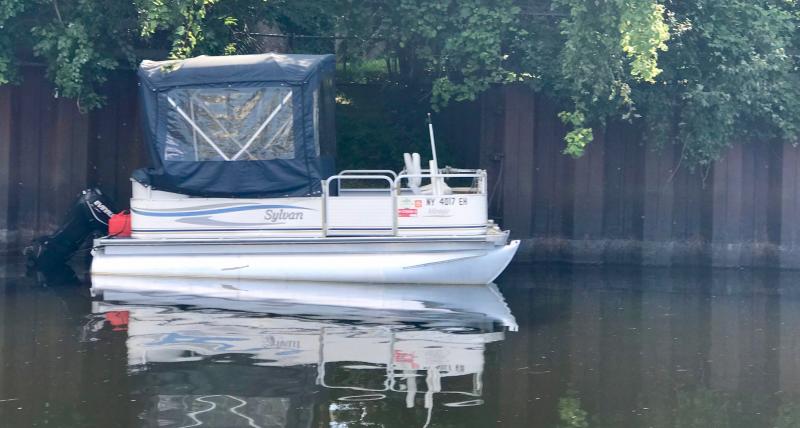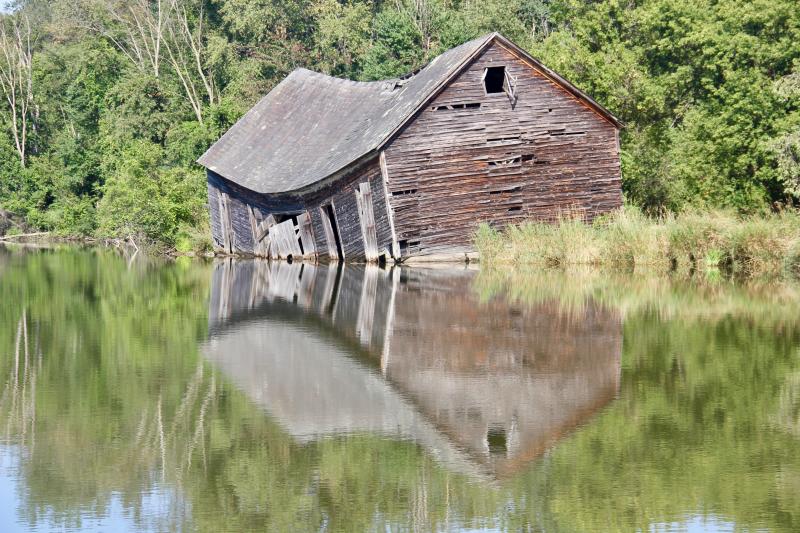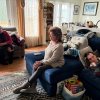HUDSON RIVER SOJOURN: Connecting the dots between fish and PCBs

FORT ANN - We started the day where we ended yesterday, at a free dock in this little canalside community. Fort Ann dates back to the early 1800s and I have a couple photos of old houses here to prove it.
Matt and Kevin, in a 1989 Formula Express Cruiser set up for rough and ready touring, told us there is a good brewpub in Fort Ann. Battery Hill. We walked a few blocks up a hill, over railroad tracks and down the Main Street past the old houses and arrived at Battery Hill.
Becky drink a seasonal called Harmony. Flavored with lavender from a local farm, the beer went down smooth.
It tasted like another to me. But at the end of the day Becky is a wino so she switched o Chardonnay. I started with a 4.5 amber which was excellent and then jumped to their War Whoop 6.5 IPA. It was good too. Fortunately for me they had 10-ounce alternatives to 16-ouncers. Light weight.
The young man at the bar next to me said Matt’s Formula probably was powered by a 454 Chevy big block. Knew something about the boats and their engines. Matt told me it would do 38 top end but at 38 it was also consuming about 15 gallons of fuel per hour. In the eight and 10 range that we run, the Formula was probably drinking about seven gallons per hour.
We went to bed about nine, with thunder and lightening starting to threaten. Two young guys - one with a head lamp on - were fishing from the dock where we were tied. I fell asleep listening to their chatter and thinking about the Hudson and its fish.
I also thought about the big fish - maybe a large-mouth bass - that I saw an osprey carrying earlier in the day. (See photo and information below.)
The words of a lockmaster at Lock 8 earlier in the day were also part of the dots I was connecting.
Just below Lock 8 I saw a huge, relatively new, concrete wharf running parallel to the canal’s West Bank. Cletes the size of anvils were bolted into the concrete at intervals along the wharf’s length. In the middle was a gently sloping chute but there were no other clues as to its purpose way up here at the top of the Hudson other than a sign that said restricted area. No activity whatsoever.
The lockmaster told me that the wharf was constructed as part of a massive environmental clean-up project. “General Electric,” he said. “The wharf was installed to handle barges employed to carry out PCB-laden sediments dredged from the section of the river and Champlain Canal between Troy and Lock 8. The project cost a billion dollars,” he said. He said GE had manufacturing facilities in the area.
“Was it effective?” I asked.
“I think they’re still trying to figure it out. But I don’t think anyone will be eating fish out of this section of the river in our lifetimes.”
I don’t know much about PCBs other than they’re a chemical compound used in electrical transformers. Apparently GE dumped waste material including PCBs into the Hudson over decades. The compounds, believed to have cancer-causing properties if ingested, polluted the river and forced the posting of the kind of signs we all hate to see regarding the inadvisability of eating fish from the river. Fish take in the water and concentrations of the PCBs get into their systems which jeopardizes those who eat the fish.
Remove or let lie?
There’s debate over whether there’s more harm in leaving the toxins lying inertly in the sediment at the bottom of the river - after all dumping has ceased of course - versus dredging them up and removing, while in the process reintroducing them into the water column where they can be ingested again. Clearly the removal option won out in the Hudson case but the jury is still out on whether the project resulted in a billion dollars worth of improvement.
All that said, Lock 8 was the last lock that lifted us, and the last section of Champlain Canal that carried Hudson River navigational markers. We found the last makers in the river - which started with number one in the New York City Harbor - at Fort Edward just above Lock 8. Starting with Lock 9 we started lowering to Lake Champlain’s level.
We ended today’s journey in Whitehall at the Whitehall Marina where we tied up after passing through Lock 12 - the final lock of our trip.
On tomorrow to Fort Ticonderoga - the high point of Benedict Arnold’s career as an American Revolutionary War officer - before entering Lake Champlain. Have a nice weekend.































































